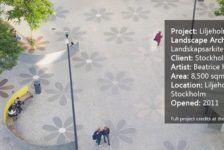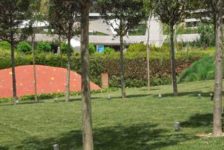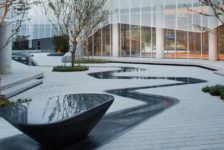Shrewsbury International School “Play Field” for Kindergarten Children, by Shma Designs, in Bangkok, Thailand. Shrewsbury “Play Field” is a shining example of a sensory-stimulating environment for kindergarten children. Going beyond the typical all-in-one play equipment — which suggests limitations for the growth of a child — Shma has created an all-encompassing play area where young children are able to experiment, explore, observe, and manipulate their surroundings. So, just how exactly is this executed? Multi-sensory play makes up a big part of the design. Stop and think about what you are doing right now or what you were doing a minute ago. Can you identify the senses you used that allowed you to gain an understanding or perform a function? Through this short contemplation, you will realize how your senses are key to survival. Inside this Article:
- Geometric Galore
- Color Coordination
- Vegetation Variety
- A Play Garden Full of Contradiction
- Thinking Through Exploring
- Full Project Credits for Shrewsbury International School “Play Field”
- WATCH: Jinsop Lee: Design for all 5 senses
- Recommended Reading
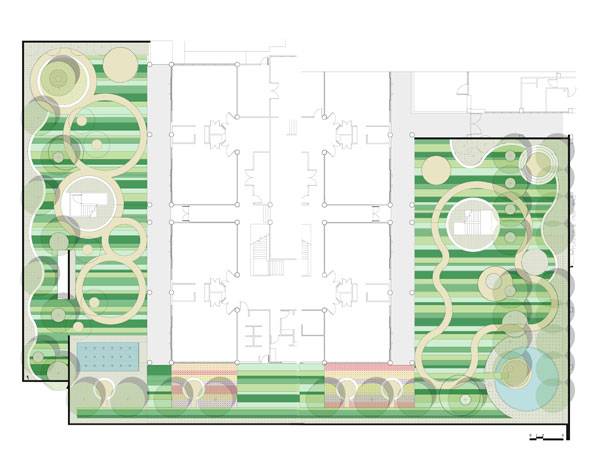
Shrewsbury “Play Field”. Photo courtesy of Shma
Shrewsbury “Play Field”
Sensory play allows children to focus on one particular sense or use all senses in different play opportunities. Such sensory stimulations — to be able to see, hear, touch, smell, and taste — are key to existence in our world as much as food and water. Some of the many benefits of a stimulating environment include the ability to learn better, aid motor and cognitive development, and improve language and social interaction skills. Shma has used the following elements in efforts to encourage children’s brain development.
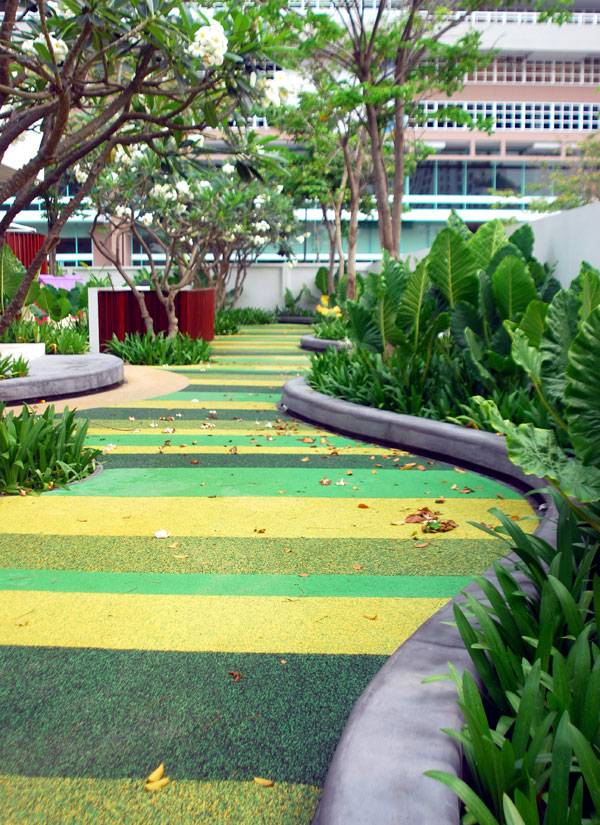
POavement pattern at Shrewsbury International School “Play Field”. Photo courtesy of Shma
Geometric Galore
One of the most noticeable things about this design is the contrast between the linear ground patterns against the circular seating and play areas. The combination produces a striking sight sure to grab the attention of any five-year-old child. The circular elements, known as “Playing Pods,” provide varied experiences. “Swirl Pod” is a maze-like structure that mimics the experience of moving through a snail shell; “Island Pod” is like being surrounded by a water plant; “Herb Pod” stimulates the sense of smell with Thai herbs; “Sand Pod” provides the all-time favorite sand play (particularly strong for stimulating the sense of touch); and lastly, “Classroom Pod” has a roof for class gatherings.
More Top Articles on LAN
- 10 of the Most Common Mistakes People Make in Planting Design and How to Avoid Them
- Interested But Not Confident? – Know How to be Good at Hand Drawings
- Top 10 YouTube Tutorials for Technical Drawing

Shrewsbury International School “Play Field”. Photo courtesy of Shma
Color Coordination
The striped ground pattern is characterized by different tones of green rubber flooring to imitate the feeling of a lawn. The colors are gentle for the children’s eyes and create a more pleasant setting. Among the linear pattern runs a meandering bicycle track that travels in and around the pods for fun bike classes. The final color pallet consists of earthy tones; here Shma managed a delicate balance between geometry and color. Both of these elements widen a young child’s vision — a sense that helps them gather the most information of the world.
Recommended Reading
- Landscape Architecture: An Introduction by Robert Holden
- Landscape Architecture, Fifth Edition: A Manual of Environmental Planning and Design by Barry Starke

Sand pod at Shrewsbury International School “Play Field”. Photo courtesy of Shma
Vegetation Variety
When it comes to multi-sensory stimulation, do not underestimate the power of planting. For example, plants such as lavender (Lavendula angustifolia) produce a strong pleasant scent; Allium spp. have large spherical shapes that can make any child feel like they are on another planet; Bamboo (Bambusa spp.) can produce whistling sounds in the wind; textural plants such as Lamb’s ears (Stachys byzantine) have a velvety soft feel (a favorite for growing with children); and any edible planting such as fruit trees are great to cultivate to educate the children.

Swirl pod Shrewsbury International School “Play Field”. Photo courtesy of Shma
A Play Garden Full of Contradiction
Keep thinking about what the “Play Field” would look like from a five-year-old’s point of view. At a first glance, the play area looks like a forest, with “glades” and swathes of green created from either the planting or the rubber flooring. There is a challenging aspect for the children, because there is always an element of contradiction.

Seat pod at Shrewsbury International School “Play Field”. Photo courtesy of Shma
More Top Articles on LAN
- 10 of the Most Common Mistakes People Make in Planting Design and How to Avoid Them
- Interested But Not Confident? – Know How to be Good at Hand Drawings
- Top 10 YouTube Tutorials for Technical Drawing
These contradictory elements are there to challenge the children to use their senses as a way of exploring and getting familiar with the space. They are not on their own. With an army of kindergarten children playing together in the play garden, they can interact with one another and share their discoveries.

Room pod at Shrewsbury International School “Play Field”. Photo courtesy of Shma
Thinking Through Exploring
Children learn to think and relate to the world around them through the exploration of their surroundings: touching wood, rubber, metal, or concrete surfaces; changing body positions and movement patterns; and so on. They have fun and “‘fun’ is a child’s word for sensory integration.” We, as adults, can relate to this, because our senses are our gateways to the world that surrounds us.

Shrewsbury International School “Play Field”. Photo courtesy of Shma
WATCH: Jinsop Lee: Design for all 5 senses
We have picked out the key elements that this project contributes to the multi-sensory play experience. Do you think Shma has the right balance or could there be more elements introduced to heighten the children’s senses?
Full Project Credits for Shrewsbury “Play Field”
Project: Shrewsbury “Play Field” Landscape Architecture: Shma Designs Client: Shrewsbury International School Location: Bangkok, Thailand Site Area: 900 sq.m. Design: 2007 Construction: 2007 Show on Google Maps
Recommended Reading
- Landscape Architecture: An Introduction by Robert Holden
- Landscape Architecture, Fifth Edition: A Manual of Environmental Planning and Design by Barry Starke
Article by Win Phyo
Published in Blog




